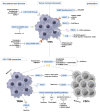Macrophages Are a Double-Edged Sword: Molecular Crosstalk between Tumor-Associated Macrophages and Cancer Stem Cells
- PMID: 35740975
- PMCID: PMC9221070
- DOI: 10.3390/biom12060850
Macrophages Are a Double-Edged Sword: Molecular Crosstalk between Tumor-Associated Macrophages and Cancer Stem Cells
Abstract
Cancer stem cells (CSCs) are a subset of highly tumorigenic cells in tumors. They have enhanced self-renewal properties, are usually chemo-radioresistant, and can promote tumor recurrence and metastasis. They can recruit macrophages into the tumor microenvironment and differentiate them into tumor-associated macrophages (TAMs). TAMs maintain CSC stemness and construct niches that are favorable for CSC survival. However, how CSCs and TAMs interact is not completely understood. An understanding on these mechanisms can provide additional targeting strategies for eliminating CSCs. In this review, we comprehensively summarize the reported mechanisms of crosstalk between CSCs and TAMs and update the related signaling pathways involved in tumor progression. In addition, we discuss potential therapies targeting CSC-TAM interaction, including targeting macrophage recruitment and polarization by CSCs and inhibiting the TAM-induced promotion of CSC stemness. This review also provides the perspective on the major challenge for developing potential therapeutic strategies to overcome CSC-TAM crosstalk.
Keywords: cancer immunotherapy; cancer stem cells; tumor microenvironment; tumor-associated macrophages.
Conflict of interest statement
The authors declare no conflict of interest.
Figures


Similar articles
-
Cancer stem cells and tumor-associated macrophages: Interactions and therapeutic opportunities.Cancer Lett. 2025 Aug 1;624:217737. doi: 10.1016/j.canlet.2025.217737. Epub 2025 Apr 22. Cancer Lett. 2025. PMID: 40274063 Review.
-
Cancer Stem Cells and Macrophages: Implications in Tumor Biology and Therapeutic Strategies.Mediators Inflamm. 2016;2016:9012369. doi: 10.1155/2016/9012369. Epub 2016 Feb 14. Mediators Inflamm. 2016. PMID: 26980947 Free PMC article. Review.
-
Cancer stem cells and tumor-associated macrophages as mates in tumor progression: mechanisms of crosstalk and advanced bioinformatic tools to dissect their phenotypes and interaction.Front Immunol. 2025 Feb 6;16:1529847. doi: 10.3389/fimmu.2025.1529847. eCollection 2025. Front Immunol. 2025. PMID: 39981232 Free PMC article. Review.
-
Cancer Cell CD44 Mediates Macrophage/Monocyte-Driven Regulation of Head and Neck Cancer Stem Cells.Cancer Res. 2020 Oct 1;80(19):4185-4198. doi: 10.1158/0008-5472.CAN-20-1079. Epub 2020 Aug 14. Cancer Res. 2020. PMID: 32816856 Free PMC article.
-
Macrophages and cancer stem cells: a malevolent alliance.Mol Med. 2021 Sep 28;27(1):121. doi: 10.1186/s10020-021-00383-3. Mol Med. 2021. PMID: 34583655 Free PMC article. Review.
Cited by
-
Metabolism in Cancer Stem Cells: Targets for Clinical Treatment.Cells. 2022 Nov 26;11(23):3790. doi: 10.3390/cells11233790. Cells. 2022. PMID: 36497050 Free PMC article. Review.
-
Macrophages in immunoregulation and therapeutics.Signal Transduct Target Ther. 2023 May 22;8(1):207. doi: 10.1038/s41392-023-01452-1. Signal Transduct Target Ther. 2023. PMID: 37211559 Free PMC article. Review.
-
Targeting cancer stem cell plasticity in triple-negative breast cancer.Explor Target Antitumor Ther. 2023;4(6):1165-1181. doi: 10.37349/etat.2023.00190. Epub 2023 Dec 11. Explor Target Antitumor Ther. 2023. PMID: 38213533 Free PMC article. Review.
-
Unveiling the Dynamic Interplay between Cancer Stem Cells and the Tumor Microenvironment in Melanoma: Implications for Novel Therapeutic Strategies.Cancers (Basel). 2024 Aug 16;16(16):2861. doi: 10.3390/cancers16162861. Cancers (Basel). 2024. PMID: 39199632 Free PMC article. Review.
-
Involvement of Cyclooxygenase-2 in Establishing an Immunosuppressive Microenvironment in Tumorspheres Derived from TMZ-Resistant Glioblastoma Cell Lines and Primary Cultures.Cells. 2024 Jan 30;13(3):258. doi: 10.3390/cells13030258. Cells. 2024. PMID: 38334650 Free PMC article.
References
-
- Abdoli Shadbad M., Hosseinkhani N., Asadzadeh Z., Derakhshani A., Karim Ahangar N., Hemmat N., Lotfinejad P., Brunetti O., Silvestris N., Baradaran B. A Systematic Review to Clarify the Prognostic Values of CD44 and CD44(+)CD24(-) Phenotype in Triple-Negative Breast Cancer Patients: Lessons Learned and the Road Ahead. Front. Oncol. 2021;11:689839. doi: 10.3389/fonc.2021.689839. - DOI - PMC - PubMed
Publication types
MeSH terms
LinkOut - more resources
Full Text Sources
Medical

